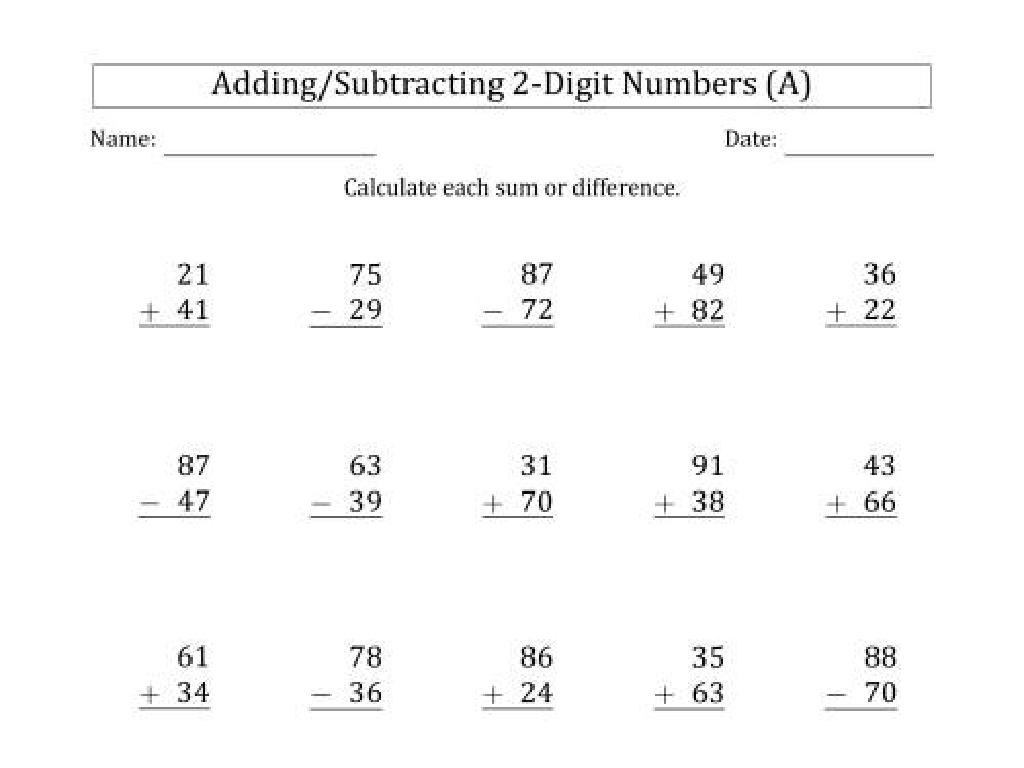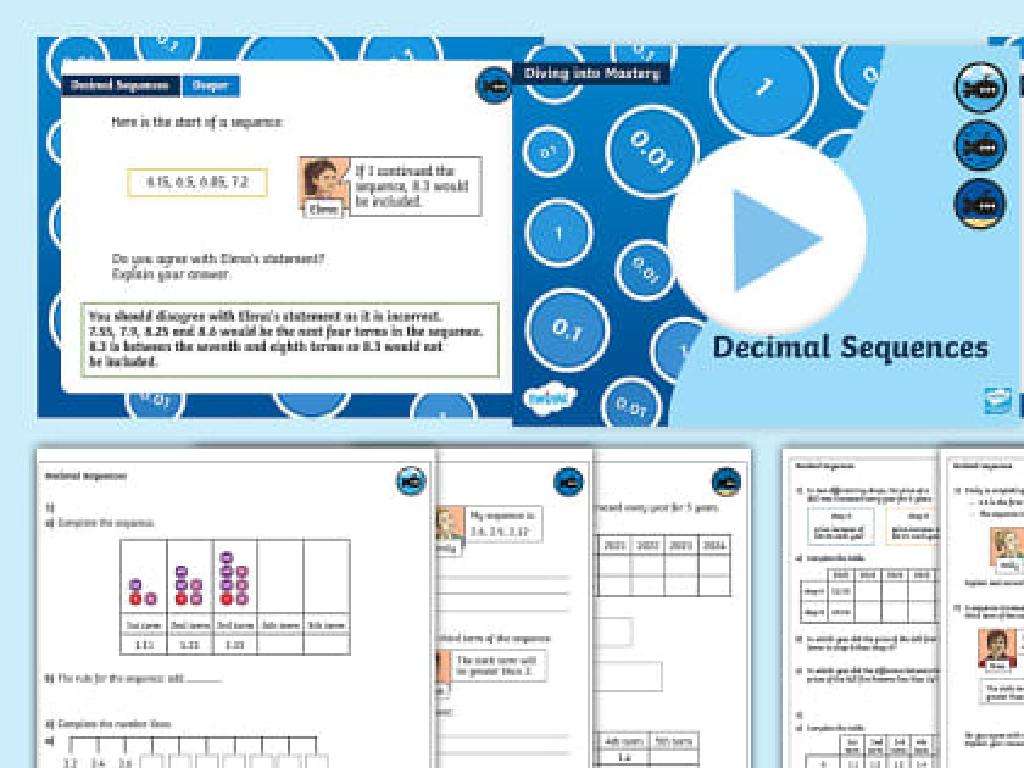Changes In Mean, Median, Mode, And Range
Subject: Math
Grade: Seventh grade
Topic: Statistics
Please LOG IN to download the presentation. Access is available to registered users only.
View More Content
Welcome to Statistics: Understanding Measures of Central Tendency
– Explore Mean, Median, Mode, Range
– Mean (average), median (middle), mode (most frequent), range (difference between highest and lowest)
– Real-life importance of these concepts
– Used in daily decisions, sports, economics, and more
– Overview of today’s lesson
– Engaging activities planned
– We’ll use examples and exercises to understand these concepts
|
This slide introduces the fundamental concepts of statistics that are crucial for understanding data: mean, median, mode, and range. Emphasize the practicality of these concepts in everyday life, such as in calculating average grades, understanding median income, or determining the most common shoe size sold. The lesson will provide a brief overview of each concept, followed by examples and class activities to reinforce learning. Encourage students to think of situations where they might need to use these measures. Activities may include group work to calculate these statistics for given data sets, real-life scenario analysis, and interactive games to solidify their understanding.
Understanding Mean in Statistics
– Mean: The average value
– Add up all numbers, then divide by the count of numbers
– How to calculate mean
– Sum all values, count them, divide sum by count
– Example: Mean of 5, 3, 7, 3
– (5 + 3 + 7 + 3) / 4 = 18 / 4 = 4.5
|
The mean, often referred to as the average, is a fundamental concept in statistics that provides a central value for a set of numbers. To calculate the mean, students should add all the numbers in a set and then divide by the total count of numbers. For example, with the numbers 5, 3, 7, and 3, the sum is 18. Since there are 4 numbers, dividing 18 by 4 gives us a mean of 4.5. It’s important for students to practice this with different sets of numbers to become comfortable with the process. Encourage them to work out the mean for various sets of numbers as homework.
Understanding Median in Statistics
– Median: Middle value in a list
– How to find median: Sort and locate middle
– Arrange numbers from smallest to largest and find the number in the center
– Example: Median of 12, 4, 5, 3, 8
– Sort the numbers: 3, 4, 5, 8, 12. Median is 5, as it is in the middle
– Class activity: Find medians in pairs
– Students will pair up, each pair will find medians of different number sets
|
The median is a measure of central tendency that represents the middle value in a sorted list of numbers. When teaching the median, ensure students understand the importance of ordering the numbers before attempting to find the median. Use the example provided to walk through the process step by step. For the class activity, prepare several sets of numbers for students to work on in pairs, encouraging collaboration and discussion. Possible activities could include finding medians from a list of ages, daily temperatures, or scores from a game.
Understanding Mode in Statistics
– Define mode in a dataset
– Mode: The most frequently occurring number
– Mode can be unimodal or multimodal
– Unimodal has one mode, multimodal has several
– No mode in a uniform dataset
– A dataset where all numbers appear once has no mode
– Example: Finding the mode
– For 2, 4, 4, 3, 2, 1, 2, mode is 2 (appears 3 times)
|
The mode is a basic statistical concept that represents the most frequently occurring number in a dataset. It’s important for students to understand that a dataset can have one mode (unimodal), more than one mode (multimodal), or no mode at all if all numbers occur with the same frequency. Use the example provided to illustrate how to find the mode in a simple dataset. Have students practice with additional sets of numbers to reinforce the concept. Encourage them to explain their reasoning process when determining the mode.
Understanding Range in Statistics
– Definition of Range
– Range is the spread between the highest and lowest numbers in a dataset.
– Calculating Range
– To find range: subtract the smallest value from the largest.
– Example: Dataset range
– For 15, 22, 8, 19, 13, range is 22 – 8 = 14.
– Significance of Range
– Range gives us a measure of data spread.
|
The concept of range is a fundamental statistical measure that indicates the spread of a dataset. It’s calculated by finding the difference between the highest and lowest values. For example, given the numbers 15, 22, 8, 19, and 13, the range is 14 (22 minus 8). This measure helps us understand the extent of variation within a set of numbers. When teaching this concept, ensure that students practice with different datasets to become comfortable with the calculation. Discuss why understanding the range is important, such as in comparing the variability of different datasets.
Impact on Mean, Median, Mode, and Range
– Effects of adding/removing a number
– Adding a number can increase the mean, while removing can decrease it.
– Uniform increase/decrease in all numbers
– If all numbers increase by the same amount, the mean, median and mode also increase.
– Class participation example
– We’ll use a set of numbers and analyze changes together.
– Understanding through interaction
|
This slide aims to explore how statistical measures change when data is altered. Start by discussing how adding a number to a data set can raise the mean, or removing one can lower it, and how these actions might affect the median and mode. Then, explain that if every number in a set is increased or decreased by the same amount, the mean, median, and mode will shift accordingly. The range will remain the same if all numbers are increased or decreased uniformly. Engage the class with an interactive example where they can suggest numbers to add or remove, and then calculate the new mean, median, mode, and range as a group. This activity will help solidify their understanding of the concepts. Prepare to guide the students through the calculations and answer any questions that arise.
Real-Life Applications of Statistics
– Statistics in daily life
– Sports: Analyzing player performance
– Average points per game or batting averages help gauge players’ consistency
– Classroom: Comparing test scores
– Median score can show typical student performance, mode can indicate common scores
– Media: Interpreting graphs and data
– News often includes statistical data; understanding mean, median, mode helps make sense of reports
|
This slide aims to show students how the statistical concepts of mean, median, mode, and range are not just theoretical but are used in everyday situations. For instance, sports analysts use these to evaluate players’ performances, teachers use them to assess test results, and understanding these concepts helps interpret weather patterns or data presented in the news. Encourage students to think of statistics as tools that help make informed decisions and understand the world around them. Provide examples like how a basketball player’s average score per game can indicate their reliability or how the most common test score in a class can show what result is most typical. Discuss how media uses statistics to convey information quickly and effectively, and why it’s important to understand these concepts to critically analyze such data.
Class Activity: Statistics in Action!
– Group data collection task
– Calculate key statistics
– Find mean, median, mode, and range of your data
– Present findings to class
– Reflect on data changes
– How do additions or removals alter your results?
|
Divide the class into small groups and assign each group the task of collecting a set of data, which could be anything from the number of books each student has at home to the number of steps they walk in a day. Each group will then calculate the mean, median, mode, and range of their data set. After calculations, groups will present their findings to the class, explaining the significance of each measure. Finally, students will discuss how changes in the data set, such as adding or removing a number, can affect the mean, median, mode, and range. This activity will help students understand the practical application of statistics and enhance their analytical skills. For the teacher: Prepare a list of possible data collection ideas, ensure students understand how to calculate each measure, and guide them on how to present their findings effectively.
Wrapping Up: Statistics in Everyday Life
– Recap of today’s lesson
– Significance of statistical measures
– Homework: Data Exploration
– Find any data set, like ages or heights, and calculate mean, median, mode, and range
– Be ready to discuss your findings
– Think about how these measures can tell different stories about the same data
|
As we conclude today’s lesson, it’s important to review the key concepts of mean, median, mode, and range. Understanding these measures of central tendency and variability is crucial for interpreting data in various fields. For homework, students should find a set of data around their home or community, such as the ages of family members or the heights of classmates, and calculate the mean, median, mode, and range. This exercise will help reinforce their understanding by applying it to real-world data. Encourage students to be creative in their data selection and be prepared to discuss how each statistical measure provides different insights into the data set they choose.





